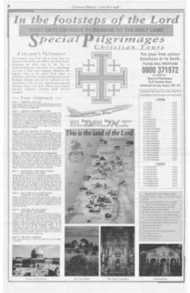Page 12, 15th May 1998
Page 12

Report an error
Noticed an error on this page?If you've noticed an error in this article please click here to report it.
Tags
Share
Related articles
The Modern Day Hermits Who Eat Of The Fruit Of Paradise
King Hal's Interest In Carthusian Sufferings
What Is The Attraction Of A Silent Life For Growing...
Ruth Everlastin
Chronicles Of Charterhouse
cHARTritH o rRETATIMTet Bilg i rtliur Wells T HE CARTHUSIAN order is endlessly interesting, because
of its very special nature; it is the one order in the Church which has never needed reform. To quote from an earlier Catholic Herald article, the Prior of the English Charterhouse at Parkaninster said: "Everything depends on a vision of faith" and it is appropriate this month to explore the effects of concreted solitary prayer on the life of faith.
The fourth of this month has recently been celebrated as May Day, but in 1535, it was marked by the martyrdom of three Carthusian priors who suffered the fearful fate of being hung, drawn and quartered at Tyburn. They were accompanied by two other priests, also notably prayerful men. The three monks had made easy their arrest by Thomas Cromwell, the King's agent. Robert Lawrence from 13eauvale and Augustine Webster from Axholrne had journeyed from the Midlands to confer with John Houghton, prior of the London Charterhouse.
Their problem was how to respond to the Acts of Succession and of Supremacy. They failed to negotiate an acceptable form of the oath: "so far as the law of God might allow" and they were first condemned to the Tower, and later to death, by a reluctant, but intimidated, jury.
Carthusians are a blend of monk and hermit; they are little known because that is their wish. They retire from the world to concentrate on God, and when they die, an unmarked cross is their only memorial. At the time of the Reformation, there were several Charterhouses in England, London was perhaps the most distinguished, but now their sole priory is in Sussex.
The life of the founder, St Bruno, can be found in any book of saints. It is often the case that groups of holy people live at about the same time, and so it was in the llth and 12th centuries. In 1084, Bruno and six companions, seeking complete solitude, moved to south-eastern France where, with the assis
tance of Bishop Hugh of Grenoble, they built an oratory and cells in the mountainous forests of "La Grande Chartreuse." St Hugh of Grenoble must not be confused with St Hugh of Lincoln, coincidentally born near Grenoble, who (for further confusion) became a Carthusian. "Our" Hugh only accepted a bishopric under obedience to the prior of "La Grande Chartreuse" and at the request of the English king, Henry H. Ironically for a hermit, Hugh of Lincoln became famous throughout Christendom as a bishop.
Bruno's rule owed more to the primitive monks and desert hermits of Egypt and Palestine than to Benedict, and Carthusian rule is espe
cially austere. There is one meal only at midday (never meat), although a man may keep something for the evening. Sleep is broken by 3. the three-hour night office. Monks each live in a small
"house," set around a cloister. ; Except for Divine Office, a
chapter business, and a short g weekly walk, the monk cw remains solitary. There is a long walk out in the country once a year.
Lay brothers live in a community, maintain the priory and prepare the food, delivered without contact through the hatch. Other necessities are requested by note and are delivered via the hatch. Each monk has a work room and a tiny, high-walled garden. Heating is primitive and, in cold weather, a brick heated in the stove is allowed to be used as a foot-warmer.
For me it is difficult to separate an account of the Order from a particular personal contact, because a Carthusian was the first monk I ever met. It was at the beginning of the war, when some rules were softened. A friend's family had known the young Fr Thomas More Brogden as a secular priest and a privi leged visit was arranged because we youngsters might be caught up in the war. In the event one of us, a Lancaster navigator, was lost over Belgium in 1944, at barely 20 years old.
But that had been a happy day at Parkminster and we
blog comments powered by Disqus













